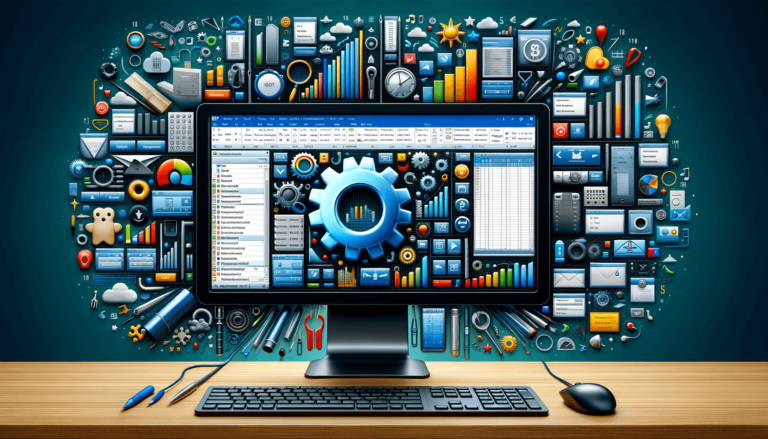

Microsoft Excel is an essential tool that has been in use for several decades. Excel has been popular due to its impressive features that allow users to create, manipulate, and organize data. Backstage view is one of the features that were introduced in Excel 2010 to streamline tasks that previously required users to navigate through several menus. Backstage view provides a centralized location to modify workbook properties, view file information, manage add-ins, and access Excel options. In this post, we’ll discuss everything you need to know about Backstage view in Excel.
Backstage view is a feature that allows users to manage and modify workbook properties. This feature is accessible in Microsoft Excel 2010 and later versions. Backstage view provides a centralized location where users can edit file information, tweak workbook properties, manage add-ins, and change Excel options.
There are different ways to access Backstage view in Excel. Here are three methods:
You can use a keyboard shortcut to access Backstage view. Press the “Alt” key and then press “F”. This will bring up the File tab menu, which is also called Backstage view.
You can also access Backstage view by clicking on the File tab at the top-left corner of the Excel window. Once you click on the File tab, a menu will appear, and you can select any option that you want to modify.
You can customize the Quick Access Toolbar to include the Backstage View option. Right-click on the Quick Access Toolbar and select “Customize Quick Access Toolbar.” From the drop-down menu, select “More Commands,” and then select “File Tab.” Click “Add” and then click “OK.”
Backstage view provides several options that allow users to manage their files quickly. Some of the common features of Backstage view are:
You can save your Excel workbooks in different formats, rename and duplicate files, as well as open recent files from Backstage view. You can also choose whether to save your files in the Excel format or export them to other formats like PDFs, CSV files, and more.
You can print your workbook or share it with other users via email or cloud services like OneDrive, SharePoint, and others.
You can set permissions on your Excel files, add digital signatures, and protect your files with passwords. You can also inspect your files for personal information and metadata that you might want to delete.
You can access Excel options and manage add-ins from Backstage view. You can configure options related to proofing, language, advanced options, and more. You can also add or remove add-ins that you want to use in Excel.
With Backstage view, you can easily modify workbook properties, manage files, and access Excel options. This feature is convenient and easy to use, and it allows users to streamline their workflow in Excel.
You can customize the Backstage view options to fit your requirements. You can add or remove the options that you want to use. For example, if you don’t frequently print or share your Excel workbooks, you can remove those options from Backstage view to make it more streamlined. You can also reorganize the options to prioritize frequently used options.
Backstage view provides several templates that can be useful for users. You can access templates for different types of workbooks, including calendars, budgets, invoices, and more. These templates provide a starting point for Excel users and can save a lot of time as they can be customized to fit the user’s needs.
While Backstage view is an essential feature in Excel, it has some limitations. Backstage view only provides a centralized location for managing files and Excel options, and it doesn’t offer any significant functionality beyond that. For instance, it doesn’t provide any advanced data analysis or automation features. Excel users will need to use other Excel features and add-ins to perform these tasks.
Backstage view in Excel is a convenient feature that provides a central location for managing workbook properties, accessing file information, managing add-ins, and configuring Excel options. It streamlines the workflow in Excel and saves time for users. However, users should note that Backstage view doesn’t provide advanced data analysis or automation features. Nonetheless, it is an essential feature that can make Excel users’ lives easier.
Here are the most frequently asked questions about Backstage view in Excel:
The main purpose of Backstage view in Excel is to provide a centralized location for managing workbook properties, accessing file information, managing add-ins, and configuring Excel options. It makes Excel users’ lives easier by streamlining the workflow and saving time.
You can do several things in Backstage view in Excel, including saving, opening, and printing files, setting permissions, adding digital signatures, inspecting files, accessing Excel options, and managing add-ins.
You can access Backstage view using three methods: using the keyboard shortcut Alt + F, clicking on the File tab at the top-left corner of the Excel window, or customizing the Quick Access Toolbar to include the Backstage View option.
Yes, you can customize the options in Backstage view to fit your requirements. You can add or remove the options that you want to use and reorganize them to prioritize frequently used options.
While Backstage view in Excel is an essential feature, it has some limitations. It only provides a centralized location for managing files and Excel options, and it doesn’t offer any significant functionality beyond that. Excel users will need to use other Excel features and add-ins to perform advanced data analysis or automation tasks.
Explore the world of Microsoft PowerPoint with LearnPowerpoint.io, where we provide tailored tutorials and valuable tips to transform your presentation skills and clarify PowerPoint for enthusiasts and professionals alike.

Your ultimate guide to mastering Microsoft Word! Dive into our extensive collection of tutorials and tips designed to make Word simple and effective for users of all skill levels.

Boost your brand's online presence with Resultris Content Marketing Subscriptions. Enjoy high-quality, on-demand content marketing services to grow your business.
